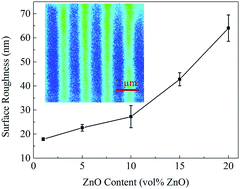Suspension-based imprint lithography of ZnO–PMMA hybrids
Abstract
Imprint lithography has been explored as a method to transfer arrays of patterned features onto pure polymers and polymer/metallic nanoparticle composites. Despite the success of this method for those materials, it has never been achieved on the sub-micron scale with polymer–oxide particle hybrids. This study patterns ZnO–PMMA (poly(methyl methacrylate)) hybrids via imprint lithography from co-suspensions of PMMA and ZnO nanoparticles in anisole from 1 vol% to 20 vol% ZnO solids loading. ZnO nanoparticles are functionalized with nonanoic acid to disperse the nanoparticles in anisole with dissolved PMMA. The feature fidelity of the patterned arrays decreases with increasing ZnO content, indicating an increase in particle agglomeration as the ZnO particle content increases. Feature size, ZnO content, and ZnO nanoparticle agglomeration are critical factors influencing the photoluminescence (PL) intensity. The ZnO solids loading at a 500 nm feature size needs to be 10 vol% or higher for the enhanced PL response. When the ridge size increases to 1 μm, ZnO solids loading as low as 1 vol% is feasible. This method of lithographic patterning of nanoparticle–polymer suspensions can be applied to a wide variety of hybrid devices and has the potential to open many applications including optical devices and biomedical screening.



 Please wait while we load your content...
Please wait while we load your content...